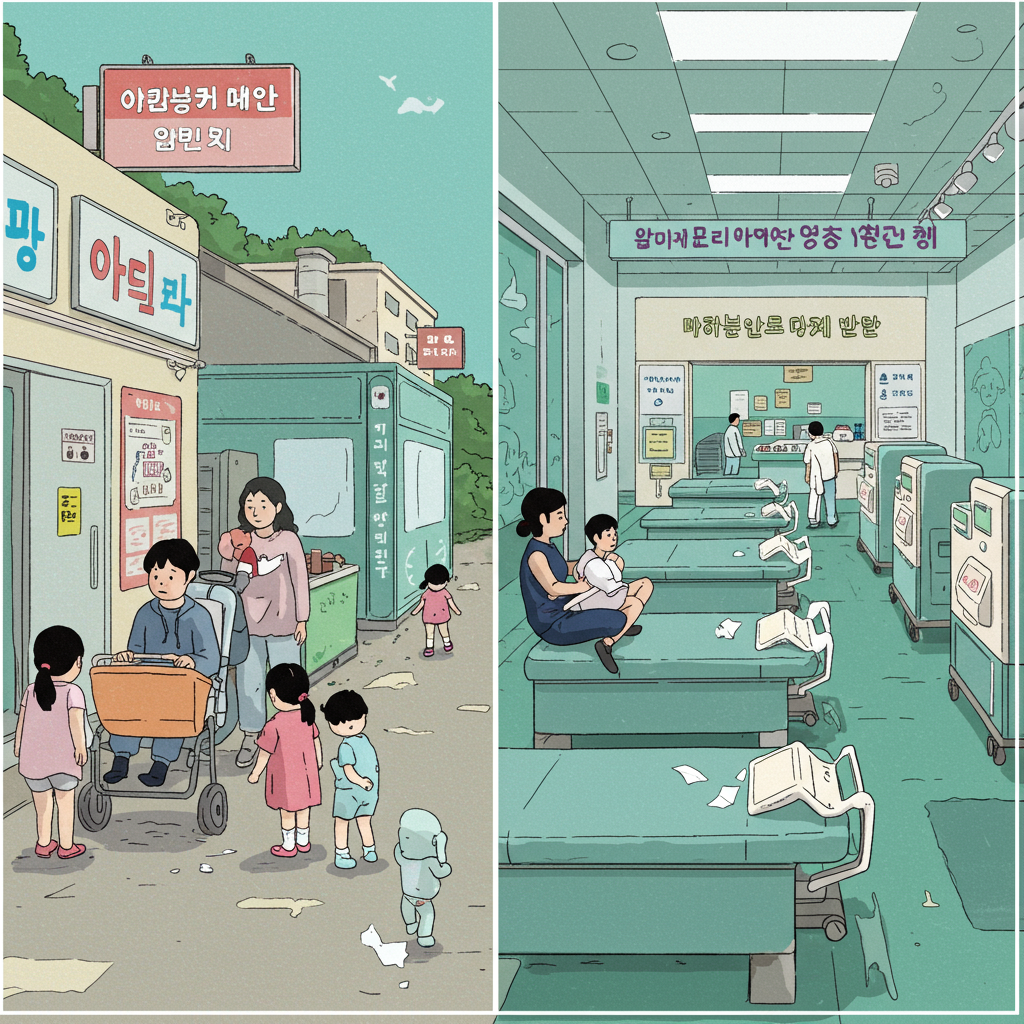South Korea holds the unfortunate distinction of having the world’s lowest birth rate, a statistic that paints a bleak picture of its demographic future. Yet, amidst this stark reality, an unexpected industry is experiencing a significant boom: fertility clinics. This paradox highlights a complex interplay of societal pressures, evolving aspirations, and the lengths to which individuals will go to fulfill their dreams of parenthood in a nation facing profound demographic challenges.
The surge in demand for assisted reproductive technology like in vitro fertilization (IVF) isn’t a sign that more Koreans are trying to have children overall. Instead, it reflects a shift among those who do desire families but face immense hurdles preventing natural conception or timely parenthood. The wait times at clinics are growing longer, illustrating this concentrated demand. As one Seoul resident, Kim Mi-ae, shared about her IVF journey, the “crazy” waits were unexpected, feeling as though everyone had made a New Year’s resolution to have a baby. Even with an appointment, delays of three hours or more are not uncommon.
South Korea’s Unprecedented Demographic Challenge
For years, South Korea’s fertility rate – the average number of babies a woman is expected to have in her lifetime – has been in steady decline. It repeatedly broke its own record for the world’s lowest rate, plummeting to 0.98 in 2018, 0.84 in 2020, and a critical 0.72 in 2023. This is drastically below the 2.1 rate needed just to maintain a population without immigration. The consequences are dire, contributing to a severe demographic crisis. One in five South Koreans is now aged 65 or older, and experts warn the population of 50 million could shrink by half within the next six decades if trends persist.
A Declining Trend and Cautious Optimism
Recently, there’s been a glimmer of cautious optimism. The fertility rate saw a slight increase to 0.75 in 2024, marking the first rise in nine years. While still far below replacement level and the global average of 2.2, this small bump is considered meaningful by some experts. Seulki Choi, a professor, suggests this could potentially signal a longer-term shift if the trend holds and attitudes towards marriage and parenthood evolve positively. However, it remains too early to declare a reversal in the country’s deep-seated demographic woes.
The Paradox: Fertility Clinics Thrive Amidst Low Births
Despite the overall drop in births, the fertility sector is flourishing. Between 2018 and 2022, the number of fertility treatments performed nationwide soared by nearly 50%, reaching 200,000 procedures. In Seoul alone last year, a remarkable one in six babies was born with the assistance of fertility treatments. This burgeoning industry is projected to exceed $2 billion in value by 2030.
Driven by Changing Attitudes and the Desire for Control
Experts point to a fundamental shift in attitudes among younger South Koreans as a key driver behind the fertility clinic boom. Unlike previous generations, who might have viewed conception as somewhat random, today’s young adults are described as being highly focused on controlling their life paths. This desire for control extends to family planning. It manifests in actions like single women proactively freezing their eggs or couples turning quickly to assisted reproductive technologies like IVF when they encounter difficulties conceiving naturally. This reflects a deliberate, planned approach to building a family when the timing feels right, rather than leaving it to chance. It’s also a powerful signal that many Koreans do wish to have children but require assistance to overcome the significant obstacles they face.
Facing the Barriers to Parenthood in South Korea
The low birth rate isn’t primarily due to a lack of desire for children; surveys indicate many South Koreans want kids but face systemic barriers. These include significant social and financial pressures.
Social, Economic, and Workplace Pressures
Deeply ingrained issues contribute to the decision to delay or forgo parenthood. Long, demanding work hours are a major factor; Park Soo-in, who delayed trying for a child due to her intense advertising job requiring late nights, knows this firsthand. High costs of living and the extraordinary expense of private education add substantial financial burdens. Traditional patriarchal norms often place the majority of childcare responsibilities on women, making it challenging for women to balance career and family. Economic uncertainty further discourages many from starting families.
The Growing Trend of Delayed Childbearing
As a result of these pressures, young Koreans often spend their prime years focused on education, career building, and saving money before contemplating marriage or children. By the time they feel financially stable or ready to settle down, they are older. The average age for a South Korean woman to have her first child is 33.6, among the highest globally. While some, like Ms. Park, feel this later timing is more realistic given their financial situation, others, like Ms. Kim, acknowledge that delaying can make natural conception more difficult, both physically and emotionally.
The High Stakes and High Costs of Fertility Treatment
For those who turn to fertility treatment, the journey presents its own unique set of challenges, particularly concerning finances and work-life balance.
Navigating the Financial Burden, Even with Subsidies
Fertility treatments, especially IVF, are expensive. Costs vary significantly depending on the individual and the number of cycles required. The unpredictable nature of these expenses can put immense strain on finances. While the South Korean government has increased support as part of efforts to boost the birth rate, offering subsidies up to 2 million won for egg freezing and 1.1 million won per IVF cycle, out-of-pocket costs for supplements, extra tests, and related expenses can still add up quickly. Kim Mi-ae reported spending over 2 million won in a single month even with subsidies.
The Impact of Treatment on Work-Life Balance
Compounding the financial stress is the demanding schedule fertility treatment requires. While companies offer leave days, women often find it difficult to utilize them due to workplace pressures. Kim Mi-ae underwent treatment for her first child without taking any leave. Jang Sae-ryeon recounted colleagues asking her to reschedule appointments, making her feel that IVF and a full-time job were incompatible. This pressure led her to quit her job, only to face financial struggles, sometimes necessitating further job hunting and delaying treatment progress. The emotional toll of repeated cycles, often ending in disappointment given the success rate below 50%, adds another layer of difficulty.
Global Context: A Challenge Many Nations Face
South Korea’s situation, while extreme, is not entirely isolated. Declining birth rates are a widespread phenomenon, affecting countries like the U.S. (1.63), Canada (1.26), Spain, Italy, and Japan, which are also categorized as having “lowest-low” fertility. Even countries that historically had higher rates, like Turkey, are experiencing dramatic slowdowns, falling to a fertility rate of 1.51 and facing rapid aging, fueled by factors similar to South Korea such as urbanization, later marriage, economic uncertainty, and pressure on youth.
Lessons from Other Countries’ Policy Efforts
Governments worldwide have attempted various incentives to boost birth rates, from financial bonuses (like those considered in the U.S., implemented in Hong Kong, Hungary, Taiwan, and Russia) to expanded parental leave and flexible work options. However, experts widely agree that simple financial incentives or symbolic gestures often fail because they don’t address the fundamental structural barriers. Effective policies require comprehensive support systems, including affordable childcare, paid parental leave, and measures to alleviate the high costs of raising children. The experience of many countries, including those with relatively generous family policies like France, Finland, and Sweden, shows that even significant efforts may only yield modest increases or fail to stop the decline, suggesting the issue is deeply rooted in global socioeconomic shifts. Simultaneously reducing funding for family support programs or imposing costs (like tariffs on baby goods) while offering incentives highlights a contradictory approach seen in some nations.
What Lies Ahead for South Korea’s Population Future?
South Korea stands at a critical demographic crossroads. The low birth rate threatens its long-term economic vitality, social security system, and even national strength. The slight uptick in 2024 offers a fragile hope, but experts emphasize the need to closely monitor societal changes and young people’s evolving perspectives on family life. The booming fertility clinic industry serves as both a symptom of the crisis and a testament to the enduring desire for family, highlighting that for many, the dream of having children hasn’t vanished, but has simply become a goal requiring significant assistance and sacrifice to achieve.
Frequently Asked Questions
Why is South Korea’s birth rate the lowest globally despite some people seeking fertility treatments?
South Korea’s incredibly low birth rate (0.75 in 2024) is primarily due to systemic social and economic barriers, not necessarily a lack of desire for children among everyone. Factors like long work hours, high costs of living and education, and traditional norms placing childcare burden on women discourage many young people from having children or cause them to delay significantly. Those who do want children but face difficulties conceiving naturally due to age or other factors are increasingly turning to fertility clinics, driving the boom in that specific sector, even as the overall birth rate remains low.
What kind of support does the South Korean government offer for fertility treatments?
As part of efforts to combat the low birth rate, the South Korean government provides subsidies for fertility treatments. These include support for procedures like egg freezing and IVF cycles. For example, subsidies can reach up to 2 million Korean won for egg freezing and 1.1 million won for each IVF treatment. However, individuals like Kim Mi-ae have noted that these subsidies may not cover all related costs, such as supplements and additional tests, leaving patients with significant out-of-pocket expenses.
What are the main challenges people face when undergoing fertility treatment in South Korea?
Individuals pursuing fertility treatment in South Korea encounter several significant challenges. One is the high cost, which can be unpredictable and substantial even with government subsidies. Another major hurdle is balancing the demanding schedule of treatment with workplace pressures. Despite official leave policies, many women find it difficult to take time off due to long work hours and company culture, sometimes leading to difficult choices between their jobs and treatment. The process can also be emotionally taxing due to low success rates and the uncertainty involved.
Ultimately, South Korea’s unique demographic situation underscores a universal truth: societal structures profoundly impact personal choices about family building. The nation’s booming fertility industry is a powerful illustration of resilience and determination in the face of overwhelming obstacles, reflecting the deep-seated human desire to create a family, even when the path is costly, difficult, and requires technological intervention. Addressing the underlying social and economic pressures remains the critical challenge for shaping South Korea’s population future.



